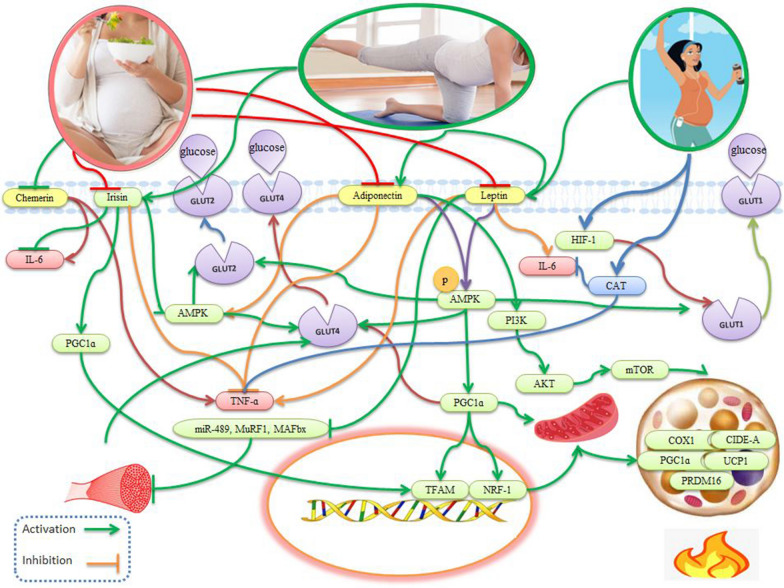Fig. 2.
Effects of exerkines and placentokines on gestational diabetes in muscles and adipocytes. Leptin increases muscle mass by suppressing miR-489 and decreasing the expression of myostatin, MuRF1, and MAFbx. Then, by activating AMPK, leptin leads to increased hydrolysis and oxidation of fatty acids and muscle triglycerides (TG). The increase of leptin in pregnancy increases the production of TNF-α, IL-6, and IL-12 by monocytes. These inflammatory cytokines increase placental leptin mRNA expression and a vicious cycle is created to perpetuate the inflammatory state and exacerbate insulin resistance. Exercise during pregnancy suppresses TNF-ɑ and leptin and leads to a significant increase in leptin receptor expression and shows an increase in leptin sensitivity and a decrease in leptin resistance. Exercise acts as an antioxidant by increasing catalase (CAT) activity and antioxidant capacity. Adiponectin binding to its receptor activates AMPK, (p38-MAPK), (PPAR-α), PI3K, and Akt. Adiponectin improves insulin sensitivity and diabetes by increasing fatty acid oxidation and glucose absorption in skeletal muscles. Adiponectin negatively regulates inflammatory markers, such as TNF-α, IL-6, and CRP. A strong relationship between physical exercise and circulating adiponectin levels has been reported in healthy and diseased subjects. Exercise-induced release of irisin directly increases metabolism through activation of AMPK, PGC-1α, nuclear respiratory factor 1 (NRF1), and mitochondrial transcription factor A (TFAM), which increases GLUT4, mitochondria, and energy expenditure. By increasing the mRNA expression of UCP1 and cidea, irisin after exercise, causes the browning of white adipose tissue and increases thermogenesis. The expression of chemerin and inflammatory factors such as IL-6 and TNF-α are significantly upregulated in the peripheral blood of gestational diabetes patients. Exercise leads to a significant decrease in serum chemerin concentration and is associated with improved glucose absorption rate, reduced inflammation, and insulin sensitivity

